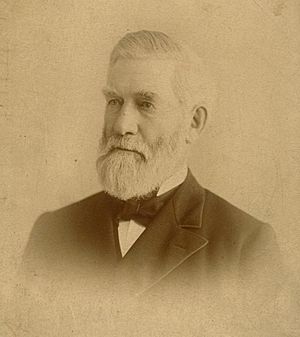Lorenzo Sawyer facts for kids
Quick facts for kids
Lorenzo Sawyer
|
|
|---|---|
 |
|
| Judge of the United States Court of Appeals for the Ninth Circuit | |
| In office June 16, 1891 – September 7, 1891 |
|
| Appointed by | operation of law |
| Preceded by | Seat established by 26 Stat. 826 |
| Succeeded by | Joseph McKenna |
| Judge of the United States Circuit Courts for the Ninth Circuit | |
| In office January 10, 1870 – September 7, 1891 |
|
| Appointed by | Ulysses S. Grant |
| Preceded by | Seat established by 16 Stat. 44 |
| Succeeded by | Joseph McKenna |
| 9th Chief Justice of the California Supreme Court | |
| In office 1868–1870 |
|
| Preceded by | John Currey |
| Succeeded by | Augustus Rhodes |
| Personal details | |
| Born |
Lorenzo Sawyer
May 23, 1820 Le Roy, New York |
| Died | September 7, 1891 (aged 71) San Francisco, California |
| Education | Case Western Reserve University Ohio Central College read law |
Lorenzo Sawyer (born May 23, 1820 – died September 7, 1891) was an American lawyer and judge. He became a judge on the Supreme Court of California in 1860. From 1868 to 1870, he served as the ninth Chief Justice of California.
Later, he became a United States Circuit Judge. He is most famous for his decision in the case of Woodruff v. North Bloomfield Gravel Mining Company. This important ruling is often called the "Sawyer Decision."
Contents
Early Life and Education
Lorenzo Sawyer was born on a farm in Le Roy, New York. He was the oldest of six children. During summers, he worked on the family farm. In winter, he went to a local school.
At age fifteen, he briefly attended a high school in Watertown, New York. There, he became very interested in law. By age seventeen, he decided to study law on his own. For the next eight years, he prepared to become a lawyer. He supported himself by teaching in schools and as a tutor.
In 1840, Sawyer moved to Ohio. He continued his studies at Western Reserve College. He also studied at Ohio Central College near Columbus. He graduated in 1846.
Becoming a Lawyer
Lorenzo Sawyer passed his law exams in May 1846. He was then allowed to practice law in Ohio. After that, he spent a year in Chicago, Illinois. He worked in the office of James A. McDougall, who later became a California Senator.
He then started a law firm in Jefferson, Wisconsin. His practice was growing quickly. But then, the California Gold Rush began.
A New Start in California
Sawyer joined a group of men from Wisconsin. They traveled across the country in just seventy-two days. This was a very fast trip for the time. He arrived in California in July 1850.
He wrote about his journey, and his stories were published in newspapers. Many people used his writings as a guide for their own trips. After working in the gold mines for a short time, he opened a law office in Sacramento.
However, he became ill and moved to Nevada City for the mountain air. He started practicing law there in October 1850. His entire law library was just eleven books he had brought with him. He stayed in Nevada City until 1853, except for a few months in San Francisco. While in San Francisco, his office burned down twice!
In 1853, he was elected City Attorney for San Francisco. He was nominated by the Whig Party. In 1854, he was nominated again by the Whig and American Party.
In 1861, he was allowed to argue cases before the Supreme Court of the United States. He also formed a law partnership. In 1862, he was offered a job as a judge for the Twelfth Judicial District. He accepted this role and was later reelected with support from both political parties.
In 1863, the state courts were reorganized. Judge Sawyer was elected a justice of the Supreme Court of California. He served a six-year term. For the last two years of his term, he was the Chief Justice. He was known for his very detailed and well-thought-out decisions.
Serving as a Federal Judge
On December 8, 1869, President Ulysses S. Grant nominated Lorenzo Sawyer to be a judge for the United States Circuit Courts for the Ninth Circuit. The United States Senate approved his appointment on January 10, 1870.
On June 16, 1891, he also began serving on the United States Court of Appeals for the Ninth Circuit. This was due to a new law called the Evarts Act. He served as a federal judge until he passed away on September 7, 1891.
The Famous "Sawyer Decision"
In 1884, Judge Sawyer made a very important ruling. It was known as the "Sawyer Decision." This decision was part of the case Woodruff v. North Bloomfield Mining and Gravel Company.
His ruling put a stop to hydraulic mining in Northern California's Gold Country. Hydraulic mining was a way of finding gold by using powerful jets of water. These jets would wash away hillsides. This method caused a lot of environmental damage, like polluting rivers with mud and debris. Judge Sawyer's decision helped protect the environment.
Helping Stanford University
In November 1885, Lorenzo Sawyer became one of the first trustees of Leland Stanford Junior University. Today, it is known as Stanford University. Trustees help manage and guide the university.

